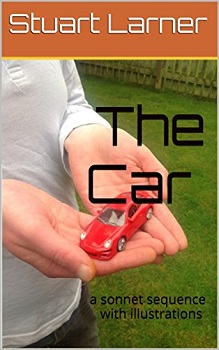The Car by Stuart Larner – Book Review
The Car by Stuart Larner – Book Review
Publisher – Cricket international
Pages – 70
Release Date – 27th September 2016
Format – ebook
Reviewer – Francesca
I received a free copy of this book
Post Contains Affiliate Links

A sequence of twenty-eight illustrated Shakespearean sonnets describing the human condition in terms of the mechanical components of a motor car. An owner’s workshop manual for servicing your life.
The text was previously published in a print magazine twenty-one years ago. Now revised, and published with illustrations. ‘The Car’ asks, and tries to answer, these kinds of questions:
If the arc across the sparking plug’s gap is an indication of love, can love’s bright spark be cultivated like the ignition timing management system?
What can be learnt about human relationships by studying the phenomenon of clutch judder?
Can we discern our path in life by the way we drive at night, and by how we use indicators, windscreen wipers and washers, and the horn?
Does automatic transmission mean our modern society has learnt to leave decisions to a box?
What does the differential bearing assembly have to say about the working of the parliamentary system?
Does studying suspension and damper arrangements have guidelines for child-rearing?
Can the process of tyre wear and braking systems inform therapy for addiction?
Is human depression treatable by learning from the fuel gauge mechanism, the radiator, and the battery?
Is there life after death in a scrap yard?

There’s a surprising number of search results for the terms ‘sonnets about cars’ but in many ways this confirms the fact that poetic forms are indeed timeless.
Within a framework any subject, emotion and message can be filled. In this case its all things auto, and through 28 sonnets Stuart Larner explore the human condition – all in terms of the mechanical components of a motor car. A sort of Haynes self manual for your life, the poems are illustrated with both photography and diagrams in its first outing as a collection, twenty-one years after original publication.
Right from Showroom Conditions to The Garden of Remembrance, set in the scrapyard, it traverses the journey of life via windscreen wipers and tyre wear. We have Checking One Out, where the teenage years are those of becoming one’s self, where ‘The mirror’s odd, my twisting body tries / To change his world, sit in it as my own /Model same as mine, the same things were spent, / Yet, in the same ways, had grown different.’
The tensions of love and it’s all its quirks are explored in through the spark plug system in lines of almost throwaway wit. ‘Your contact laughter makes and breaks my heart. / Am I competing with the other plugs? / You visit me in turn, but never start. / Am I too close or far away for hugs?’ I writing the poem, Larner hoped to see ‘can love’s bright spark be cultivated like the ignition timing management system?’
In Emission Control not only are fumes discussed, but the guidance and words of the tom tom, and it’s selective phrases – a little like our selective vocabulary where ‘We tune the complexities of the mind / To say who we were by what’s left behind.’ Ageing shows up on our bodies ‘How we face life wears patterns in our tread: / Shying away scuffs just our outer skin’ in Patterns of Wear. And the boot, an image for our deepest subconscious indeed – ‘Now I can go all day without thinking / About the boot. I hide things dark inside. / Secreting is comforting. No linking / Me with it. Locked. Have I nothing to hide?’
It feels far fetched to think that we can learn about human relationships by studying the phenomenon of clutch judder, or discern our path in life by the way we drive at night, and I’m sure that Larner has his tongue wedged in his cheek as he asks ‘Can the process of tyre wear and braking systems inform therapy for addiction?’ As metaphors the work is clear and can potentially be powerful.
At its root, divorced from our elevation of traditional forms or moved away from its Shakespearean association, a sonnet is a form in which two related but differing things to the reader are positioned in dialectical form in order to communicate something about them. Larner has done this in a way that is accessible, entertaining, and thought provoking.
Three stars, or a Volvo – solid, not spectacular.
Book Reviewed by Francesca
Purchase Links







